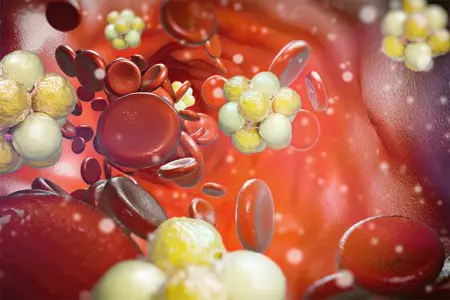Contents
- What is urate and how is it different from uric acid?
- Are There Benefits to Elevated Uric Acid Levels?
- The rate of uric acid in the blood
- When, where and how should I take a blood test for uric acid?
- Causes of an increase in uric acid
- Symptoms of High Uric Acid
- Aftermath
- How to remove uric acid from the body?


Uric acid is a waste product of purine and nucleic acid metabolism. The breakdown of purine molecules is carried out under the action of the enzyme xanthine oxidase. Uric acid cannot be attributed to a compound that is of no value to humans; it has a special role in the life of the body.
Purines are the main building material of this product. They are compounds of a multiple nature, providing most of the basic processes. It should be noted that their concentration is not constant. She is in dynamic equilibrium. During the process of disintegration of excess product, it is converted into uric acid.
Uric acid in the blood is increased due to kidney disease, endocrine diseases, eating disorders. All reasons will be discussed below.
It should be noted that uric acid and urea are completely different substances that should not be confused.

What is urate and how is it different from uric acid?

During the breakdown of purines in the liver, crystals are formed, consisting of oxygen and carbon, nitrogen and hydrogen, that is, uric acid. Its excretion from the human body is carried out by the kidneys. Certain foods contain purines, including legumes, liver, beer, and anchovies. In a small amount, this compound is found in urine, blood, sweat, liver and brain tissues. The sodium and potassium salts of uric acid, which form a precipitate in the urine, are called urates. They are synthesized from this compound. The level of uric acid is checked by two methods: in the urine and in the blood. In the first case, a urine test is performed, in the second, a biochemical blood test is performed.
The presence of an acceptable dose of this substance for the human body is not harmful, on the contrary, it is involved in a number of important physiological functions:
Raises the degree of influence of catecholamines on the cells of body tissues, stimulating the work of the brain and various parts of the nervous system.
Prevents the degree of negative effects of radicals on the body.
Performs control over the qualitative composition of body cells.
Are There Benefits to Elevated Uric Acid Levels?

Many are surprised by the fact that some researchers are convinced that a high blood level of a purine metabolic product has a positive effect on the body and makes it possible to correct certain pathological conditions:
Back in the 1960s and 1970s, numerous studies were carried out, and it was proved that patients with acute hyperuricemia have a higher level of intelligence and sharpness of reaction. This is because uric acid is chemically similar to trimethylated xanthine caffeine. Therefore, the researchers believe, it affects the increase in performance.
Higher than average levels of acid contribute to life extension while acting as an antioxidant that inhibits superoxide and peroxynitrite, iron-catalyzed oxidative reactions. Strengthening of antioxidant activity and activation of endothelial function occurs as a result of transfusion of uric acid.
This compound is a powerful neuroprotector, inhibitor of neuroinflammation and neurodegeneration. It also significantly reduces the risk of Alzheimer’s and Parkinson’s disease.
It should be noted that a characteristic effect occurs with a sharp increase in acid in the blood. Chronic hyperuricemia has other consequences: endothelial dysfunction and the development of an oxidative process occur.
The rate of uric acid in the blood
UA – the abbreviation of uric acid on the form of taking a biochemical blood test, the indicators themselves are measured by a unit – μmol per liter (μmol / l).
The norm in women
Depending on the age of the examined woman, the norm indicators may be different. Still, the difference is not so great if we consider the range of a small period of time. Based on 3 main periods.
Age (years) | Uric acid is normal |
Until 16 | 120-350 |
Until 60 | 200-310 |
Older than 60 | 120-470 |
The norm in men
Compared to women, uric acid levels in men are initially higher. The difference is from 30 to 90 units, it is due to the peculiarities of physiology, hormonal levels, daily activity and other factors. This level is predetermined by nature and biochemical processes.
Specific data, taking into account age, are presented below:
Age | Normal concentration |
Up to 16 years. | 150-350 |
17-60 years. | 250-400 |
Over 60 years old. | 210-500 |
The data of the research results are analyzed by a specialized specialist. Basically, these are endocrinologists, others are also involved, if necessary.
The norm in children
The indicators are also tied to three key moments in the lives of children.
Age | Uric acid levels |
Up to 1 month | 140-290 |
Up to a year. | 140-210 |
1-16 years. | 160-500 (adjusted for gender, since in men, volumes will be approximately 10-20 units larger). |
When determining, it is necessary to take into account temporary hormonal rises. This mainly concerns puberty, which originates from 11-12 years.
Norm during pregnancy
The indicators are affected by the trimester, the stages of gestation.
Trimester | Indicators |
I | 120-250 |
II | 140-297 |
III | 185-375 |
When, where and how should I take a blood test for uric acid?

A biochemical blood test will show the content of the level of uric acid. The analysis is carried out for preventive purposes to healthy people, and also patients with a diagnosis of diseases that predetermine a delay in its removal from the body are examined. These diseases include: diseases of the cardiovascular system, diabetes, gout and so on.
The preparation of the patient for testing seriously affects the objectivity of the indicators. To obtain a reliable result, the patient should not eat juices (fruit and vegetable), drinks (alcohol and caffeine), chewing gum the day before the procedure. In addition, it is recommended to reduce the level of physical and mental stress. Blood is donated on an empty stomach in the morning, eating in the evening should be no later than twelve hours before the donation. It is forbidden to smoke for at least one hour before taking blood for analysis.
Venous blood from the vessels passing in the cubital fossa is suitable for research. The taken blood is examined within 24 hours, the patient receives the result the next day. If it is necessary to conduct a blood test urgently, then it is carried out in two to three hours.
Causes of an increase in uric acid
If uric acid is elevated in the blood, the causes may be a number of diseases:
Hypertension
With arterial hypertension of the second stage, an increase in the level of uric acid occurs. The reason is damage to the kidneys, which leads to an aggravation of the underlying disease. During the course of treatment for hypotension, uric acid levels can be normalized without special therapy. If this does not happen, the patient must adhere to a special diet, increase physical activity, and undergo therapy prescribed by a specialist.
Gout

In the case of an increase in uric acid in gout, a high number of formations of purine bases is observed. With gout, the kidneys are the first to suffer, followed by the development of renal failure. The impact is also applied to the joints, but changes in them occur at a slower pace. The level of pathological transformation is commensurate with the level of uric acid: the higher it is, the more the kidneys suffer. But that’s not all, hyperuricemia is the cause of the development and aggravation of atherosclerosis, arterial walls are affected. As a result, patients diagnosed with gout are much more susceptible to cardiovascular disease.
Endocrine diseases

The disease hypoparathyroidism is characterized by another negative change – the appearance in the blood of a high content of calcium, which is excreted from the bones.
In diabetes, a large amount of sugar in the blood + hypersular hormones lead to irreversible changes in various types of metabolism. It is possible that even the nuclear material of the cells is destroyed, as a result of which a secondary change in the level of uric acid occurs, and this process no longer depends on the efficiency of the kidneys.
Excessive synthesis of growth hormone is called acromegaly, it manifests itself in the form of a disproportionate change in body parts – their increase. Pathology is characterized by a failure in the exchange of purine nucleotides and, as a result, uric acid is elevated in the blood.
Overweight
Obesity is a companion of hypertension, gout, diabetes mellitus. Medicine knows the stamp of the metabolic syndrome, which has recently become a paramount problem: overweight + consistently high blood pressure + diabetes mellitus. Each of these changes in the body contributes to the emergence and progression of hyperuricemia.
High lipoprotein and cholesterol levels

Very often, a signal of obvious clinical symptoms of gout and arterial hypertension is preceded by a sudden increase in these two components of the lipid profile. Changes in arteries of the atherosclerotic type affect various vascular pools.
Uric acid is an accelerator of oxidative reactions of reduced aggregate lipoproteins and lipid peroxygenation. In the process, the resulting oxidative stress causes the further development of atherosclerosis. In addition, uric acid becomes involved in platelet adhesion and aggregation, increasing the risk of progression of coronary thrombosis.
Kidney stones
Uric acid is one of the substances that form stones, its excess becomes the reason for their presence in the kidneys. The excretion of acid by the kidneys in insufficient volume indicates a number of pathologies: renal polycystosis, their insufficiency, acidosis, nephropathy during the period of lead poisoning, as well as an exacerbated form of toxicosis in pregnant women.
Diseases of the blood
In the case of blood diseases, in addition to the breakdown of its components, the process of disintegration of tissue components begins with an increase in the index of purine bases. Hyperuricemia is a sign of polycythemia, B12 deficiency anemia, leukemia, congenital and acquired hemolytic anemia.
Asymptomatic course of the disease
Studies prove that every 5th citizen of Belarus and Russia has an increased level of this compound in the blood without pathology of a clinical nature. Scientists believe that this condition can be attributed to an independent risk factor for cardiovascular disease.
Other pathologies

Diseases that occur with a large tissue decay. An obvious example is burn shock. In renal failure, the period of excretion of the metabolic product by the kidneys is prolonged.
Lesch-Nyhan genetic disease – is one of the reasons for the increase in uric acid in the blood. In the presence of such a diagnosis, the accumulation of purines occurs.
Down Syndrome – a disease with a violation of purine metabolism.
Erectile disfunction. An increase in the degree of the product of purine metabolism in the blood six times increases the risk of progression of erectile dysfunction.
Non-specific factors:
The use of drugs: Furosemide, Aspirin, Phenothiazines, Theophylline, Adrenaline and others.
Food rich in purines. It’s no secret that gout is called a disease of aristocrats, that is, people who consume excessive amounts of red wine, meat, fish, offal. All of them contain an excessive amount of purines.
Alcohol consumption, in the first place – beer, red wines saturated with purines. In addition, alcohol adversely affects the functioning of the kidneys and liver, which also leads to the accumulation of uric acid.
Permanent diets, which are the cause of dysfunction of the excretory process of the kidneys.
Great physical activity – one of the causes of hyperuricemia due to the use of an increased amount of protein and its breakdown.
Symptoms of High Uric Acid

An increase in the level of uric acid in the blood at the initial level mostly resolves without obvious symptoms. A person can learn about these indicators by chance, taking tests for a preventive examination or as directed by a doctor to diagnose another disease.
The following symptoms may indicate a rise in uric acid levels:
Pain in the joints of the legs and arms due to the crystallization of salts in them.
Suspicious skin spots, small ulcers that have appeared in the last period.
Decreased amount of urine output.
Elbows and knees become reddish.
Instability of pressure indicators (sudden rises and falls), changes in heart rate.
Treatment of hyperuricemia is carried out in the presence of these symptoms. Other causes are eliminated by following the regime and determining the products recommended for nutrition. A person must in any case follow a special diet.
Aftermath
High levels of uric acid in the blood provoke the most common disease – gout. Inflammation of the joints, arthritis indicate upward changes in indicators. These diseases are accompanied by acute pain of those who suffer from them. A person can become disabled for this reason.
Hyperuricemia raises the risk of progression of gout at times, since uric acid tends to accumulate in the blood, followed by the formation of microscopic crystals in the joints. These particles have the property of penetrating the synovial joints and thereby provoke pain. It occurs during movement, when friction occurs.
How to remove uric acid from the body?
Before starting treatment for elevated uric acid in the blood, it is necessary to establish the cause of this condition. When the cause is established, the treatment of the underlying disease begins, while at the same time additional methods are used: the necessary diet is recommended, work is underway to normalize weight, the consumption of the required volume of liquid is controlled, medication is prescribed, and folk methods are used. Let’s consider each point in more detail.
Medications that lower uric acid in the blood

All medicines should be used strictly as prescribed by a specialist, in addition, he regularly monitors the presence of acid in the blood and urine.
Diuretics. Their purpose is to accelerate the excretion of this substance in the urine. The prescription of drugs in this group is established strictly separately for each patient. The patient takes them in a course and passes the control of indicators of the level of acid in the blood and urine.
Allopurinol. Slows down the synthesis in the liver by inhibiting the enzyme xanthine oxidase. The course of therapy is long – from 2 to 3 months, requires absolute adherence to the punctuality of the reception. Analogues include drugs: Milurit, Zilorik, Foligan, Allopur, Apurin, Atizuril, Uridozid, Xanthurate, Uriprim.
Benzobromarians. The medicine affects kidney function. It performs a uricosuric action, inhibits the absorption of uric acid in the proximal renal tubules, and also inhibits enzymes that are involved in the synthesis of purines. Analogues: Khipurik, Normurat, Dezurik, Exurat, Azabromaron, Maksurik, Urikozurik, Urinorm.
Sulfinpyrazone. Stimulates the excretion of acid through the urinary system, especially effective at the initial stage of gout therapy. Analogues: Anturidin, Enturan, Sulfazon, Sulfizon.
Etamide. It inhibits the reverse absorption of uric acid in the tubules of the kidneys, thus reducing its content in the blood.
TOP 8 medicinal herbs with the best diuretic effect

Erva Woolly. Erva woolly has a pronounced diuretic effect. In addition, the plant stabilizes the water-salt balance, removes excess uric acid, chlorides and urea. And also extinguishes inflammation in the organs of the urinary system.
Bearberry. Bearberry is effective in the treatment of urolithiasis, it is an excellent diuretic. In complex therapy, it is prescribed for antibacterial effects and disinfection of urine, in addition, it raises the resistance of kidney cell membranes.
Rose hip. Rosehip roots are used to normalize salt metabolism in the body, which is a blocker of further stone formation. Rosehip root makes it possible to get rid of urolithiasis.
Horsetail. Horsetail has a strong diuretic effect. In addition, it is valued for its antibacterial and antioxidant properties. But it is not recommended to use it for more than 6 weeks to prevent cramps and potassium excretion.
Orthosiphon. Orthosiphon stamens is a wonderful diuretic used in diseases of the kidneys and urinary tract in the form of teas. The plant also has a slight antispastic effect.
Cornflower blue. Blue cornflower flowers are known for their diuretic properties. It is prescribed for cardiac and renal edema, nephritis, cystitis, urethritis. They have a choleretic property, are used in chronic diseases of the liver and biliary tract.
Birch. Birch leaves and buds have diaphoretic, diuretic, choleretic, expectorant, antiseptic, antiviral, anti-inflammatory and antifungal effects.
Diet

With a high content of uric acid, nutrition is of great importance. It should be balanced and dietary, salt in the diet is reduced to a minimum.
Diet prohibits the use of:
Alcoholic drinks.
Rich broths.
Meat and fish fatty dishes, smoked meats, offal, sausages, etc.
Spicy condiments, snacks, sauces, pickles and other foods containing excessive amounts of sodium salts.
It is also recommended to reduce the use of certain foods in the diet:
Legumes, mushrooms.
Chocolate, coffee, cocoa.
Tomatoes, spinach.
However, you need to eat:
Green apples of different varieties.
Onion and garlic.
Citrus fruits and lemons.
White and black bread.
Dill greens.
Eggs – 3 per week.
Green or herbal tea.
Carrots and pumpkin.
Beets, watermelons.
Cucumbers and white cabbage.
Cottage cheese, kefir, sour cream.
Potatoes prepared in any way.
Lean boiled meat and fish.
Rabbit, chicken and turkey meat boiled and then baked;
All kinds of vegetable oils, especially olive.
You should drink up to two and a half liters of pure water per day.
The principles of the basic diet with an elevated level of uric acid must be followed constantly, otherwise the disease may occur again. Specialists, after examining the analyzes, will help you choose the necessary products and make a diet.
[Video] Dr. Berg – How to remove uric acid?









